Setting Up the GroupWise Agents
After creating a new domain or post office, you need to configure the Agent object that was automatically created with it, then follow the setup instructions for the platform where you are installing the GroupWise agents:
- Configuring New Agent Objects in eDirectory
- Setting Up the GroupWise Agents on NetWare
- Setting Up the GroupWise Agents on Linux
- Setting Up the GroupWise Agents on Windows
Configuring New Agent Objects in eDirectory
When you create new post offices and domains, Agent objects are automatically created for them. Most agent configuration can be done after installation, but a few settings should be established before you install the agent software.
In ConsoleOne:
-
Browse to and expand the eDirectory container where the new post office or domain is located to display its contents.
-
Select the Post Office object or Domain object to display its contents.
-
Right-click the Agent object, then click Properties to display the agent Identification page.
-
In the Description field, type a brief description of the agent for display at the agent console.
-
In the Platform field, select NetWare, Linux, or Windows.
-
Click OK to save the new Agent object properties.
-
Repeat these steps for each new post office and domain for which you are installing agents.
-
Continue with the installation instructions for the platform where you are installing the GroupWise agents.
Setting Up the GroupWise Agents on NetWare
Complete the following tasks to set up the GroupWise NetWare agents. These tasks are designed to help you get the agents up and running as quickly as possible.
- Preparing the NetWare Server for the Agents
- Installing the NetWare Agent Software
- Editing the NetWare Agent Startup Files
Preparing the NetWare Server for the Agents
Make sure the NetWare server where you plan to install the GroupWise agents has been properly prepared to run the agents:
- Obtaining a Static IP Address
- Creating a NetWare Account for Agent Access (Optional)
- Adding the NetWare Agent Installation Directory to the Server Search Path (Optional)
Obtaining a Static IP Address
The NetWare server where the GroupWise agents run should have a static IP address. DHCP should not be used to dynamically assign an IP address for it. Make sure the server where you plan to install the agents has a static IP address.
Creating a NetWare Account for Agent Access (Optional)
When the GroupWise agents run on a different NetWare server from where their directories and databases are located, and they are not set up to authenticate through eDirectory (using the /dn startup switch), the agents must use a specific eDirectory username and password to log in to that server.
To create a user for the agents to log in as:
-
In ConsoleOne, create a new user (such as GWAgents).
-
Provide a password for that user (such as GWise).
-
Grant that user the following rights to all domain, post office, and document storage directories:
- Read or execute files
- Write to files
- Create files or directories
- Erase files or directories
- Modify files (rename or change attributes)
- File scan
-
Add the /user and /password startup switches to the agent startup files so that the agents can log in to the remote server as the user you have created.
Installing the NetWare Agent Software
After you have prepared the NetWare server to run the GroupWise agents, you are ready to install them.
At a Windows machine:
-
Map a drive to the NetWare server where you want to install the agents.
-
Make sure you have sufficient rights to install software in the desired directory.
-
Run setup.exe at the root of the GroupWise 6.5 Administrator CD > click Install Products > GroupWise Agents > Install GroupWise Agents.
or
Run install.exe from the \agents subdirectory on the CD or in your software distribution directory if you have updated it with GroupWise 6.5 software.
-
Follow the on-screen instructions to install the GroupWise agents on the NetWare server, supplying the information you gathered on the GroupWise Agent Installation Worksheet, until you reach the Installation Complete page.
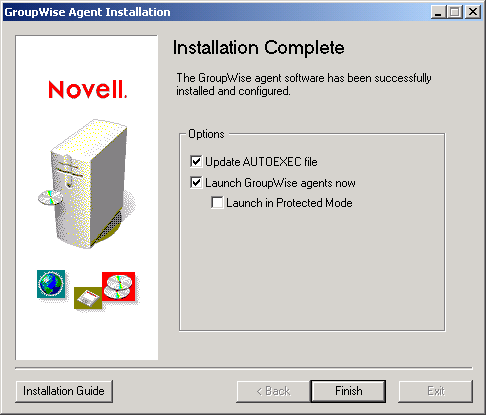
The Agent Installation program has created a grpwise.ncf file that contains the commands to start the GroupWise agents on the NetWare server whenever the server starts. Here at the end of the Agent Installation program, you can select how you want to start the agents.
Update AUTOEXEC File: Select this option if you want the Agent Installation program to add the grpwise.ncf file to the NetWare autoexec.ncf file so that the agents start automatically whenever the server restarts.
Launch GroupWise Agents Now: Select this option if you want the Agent Installation program to start the agents for you immediately. This is appropriate when you have installed the agents on the same server with the domain and post office directories.
If you have installed the agents on a remote server from where the domain and post office directories are located, do not select this option. You must manually edit the agent startup files to configure the agents to access the remote servers. This configuration procedure is explained in Editing the NetWare Agent Startup Files.
Launch in Protected Mode: If you want the Agent Installation program to launch the agents for you, you can choose to launch them in Protected Mode on NetWare 5.1 and later. This option also adds the protect command to the grpwise.ncf line in the NetWare autoexec.ncf file:
protect grpwise.ncf
This line automatically starts the agents in Protected Mode when the server restarts.
-
Select the desired agent startup options, then click Finish.
If you encounter any problems starting the agents or if you chose not to have the Agent Installation program start the agents for you, refer to "Post Office Agent" and "Message Transfer Agent" in the GroupWise 6.5 Administration Guide for additional instructions.
If you need the stop the agents, press F7-Exit at the agent console or enter unload gwpoa and unload gwmta at the NetWare server console.
-
If necessary, modify the agent startup files as described in Editing the NetWare Agent Startup Files, then manually start the NetWare agents by running grpwise.ncf.
-
To monitor an agent from your Web browser, view the agent Web console by supplying the IP address and port number of the agent. For example:
http://172.16.5.18:1677
http://172.16.5.18:7100
http://172.16.5.18:7180
http://172.16.5.18:7181When viewing the agent Web console, you can specify the POA client/server port, the MTA message transfer port, or the HTTP port you specified when you created the domain or post office. The POA client/server port and the MTA message transfer port are automatically redirected to their respective HTTP ports.
Editing the NetWare Agent Startup Files
The Agent Installation program creates a customized agent startup file for each domain and post office location. The first 8 characters of the post office and domain names became the names of the agent startup files, along with an agent-specific extension. For example, if the post office name is acctpo, then the POA startup file is named acctpo.poa. The Agent Installation program also customizes each startup file with the correct /home switch setting, pointing to the domain or post office directory.
Each startup file also provides a comprehensive list of startup switches, with all but the /home switch commented out. You can use any ASCII text editor to set the startup switches required by the access method you recorded under Worksheet Item 2: Agents and Locations. The agent startup files are located in the agent installation directory.
After modifying the startup files, use the grpwise.ncf file to start the NetWare agents from the NetWare server console.
Setting Up the GroupWise Agents on Linux
Complete the following tasks to set up the Linux agents. These tasks are designed to help you get the Linux agents up and running as quickly as possible and to help you manage the agents in the future.
- Installing the GroupWise Agents on Linux
- Installing the GroupWise Agents Using the Text-Based Installation Advisor
- Starting the Linux Agents with a User Interface
- Starting the Linux Agents as Daemons
- Monitoring the Linux Agents from Your Web Browser
- Using Agent Startup Files
- Starting the Linux Agents on System Startup
- Stopping the Linux Agents
Installing the GroupWise Agents on Linux
-
Open a new terminal window, then enter the following command:
xhost + localhost
If you cannot execute this command because the X Window System is not running on the Linux server, see Installing the GroupWise Agents Using the Text-Based Installation Advisor
-
Become root by entering su and the root password.
-
Change to the root of the GroupWise 6.5 for Linux Administrator CD.
-
Start the GroupWise Installation Advisor.
./install
-
Select the language in which you want to run the Installation Advisor and install the agent software, then click OK.
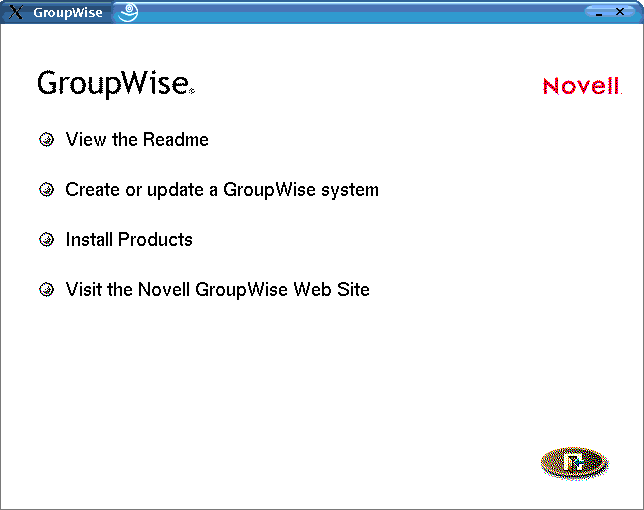
-
In the Installation Advisor, click Install Products > GroupWise Agents > Install GroupWise Agents.
-
When the file copy is complete, click OK.
The GroupWise agent software is installed to the bin and lib subdirectories of /opt/novell/groupwise/agents.
-
Click Configure GroupWise Agents.
The agent installation and configuration steps are separate so that you can install updated agent software without needing to repeat the agent configuration steps.
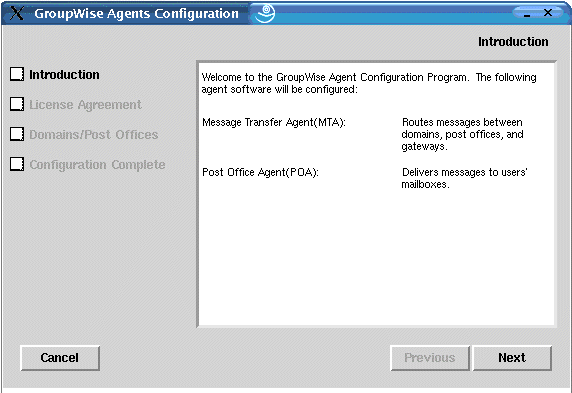
-
Review the Introduction, then click Next.
-
Accept the License Agreement, then click Next.
-
Provide the domain and post office information that the agents need:
-
Click Add, select Domain, specify the domain name and domain directory, then click OK.
-
Click Add, select Post Office, specify the post office name and post office directory, then click OK.
-
Verify that the names and directories you have provided are correct, then click Next.
On the Configuration Complete page, Launch GroupWise Agents on System Startup is selected by default.
-
-
If you do not want the agents to start automatically when the server restarts, deselect Launch GroupWise Agents on System Startup.
-
Click Exit to complete the configuration.
-
Skip to Starting the Linux Agents with a User Interface or Starting the Linux Agents as Daemons depending on whether or not you want a user interface on the Linux server where the agents run.
Installing the GroupWise Agents Using the Text-Based Installation Advisor
If you want to install the GroupWIse agents on a server where the X Window System is not running, you can use the text-based Installation Advisor.
-
Make sure you are logged in as root.
-
Change to the root of the GroupWise 6.5 for Linux Administrator CD.
-
Start the GroupWise Installation Advisor.
./install
-
Press any key to display the License Agreement.
-
Press any key to scroll through the License Agreement, then enter y to accept the License Agreement.
-
Enter 1 for GroupWise Agents.
-
Enter 1 for Install GroupWise Agents.
A status bar indicates progress.
-
Enter y to configure the GroupWise agents.
-
Enter 1 to continue.
-
If you want to configure the MTA, enter 1 to specify the domain, enter the domain name, then enter the path to the domain directory.
-
If you want to configure the POA, enter 2 to specify the post office, enter the post office name, then enter the path to the post office directory.
-
Enter 3 to review the information you have provided, then press any key to continue.
-
Enter 4 to configure the agents, then press any key to exit.
-
Skip to Starting the Linux Agents as Daemons.
Starting the Linux Agents with a User Interface
-
Make sure you are logged in as root.
-
Change to the GroupWise agent bin directory.
cd /opt/novell/groupwise/agents/bin
-
Enter the following command to start the MTA:
Syntax:
./gwmta --show --home domain_directory &Example:
./gwmta --show --home /gwsystem/domlnx &The --show startup switch starts the MTA with an agent console interface similar to that provided for the NetWare and Windows MTA. This user interface requires that the X Window System and OpenMotif be running on the Linux server.
The --home startup switch specifies the domain directory and is required to start the MTA.
The ampersand (&) causes the MTA to run in the background, so that the terminal window you started it in is again available for use.
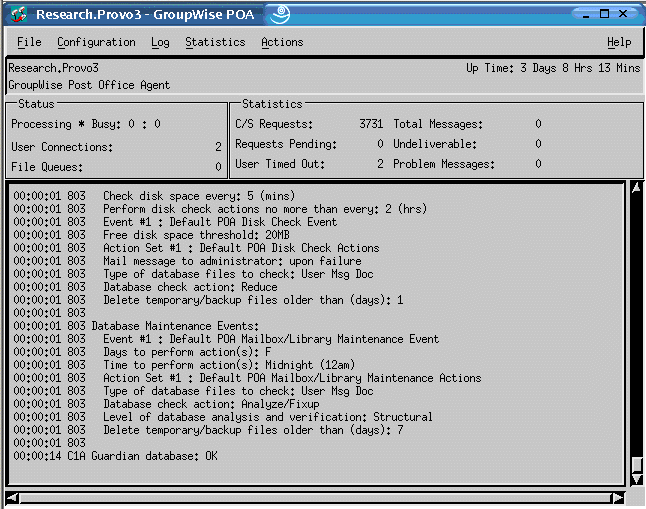
The status messages displayed on the MTA agent console are also written to the MTA log file (mmddmta.nnn) in the /var/log/novell/groupwise/domain.mta directory. The log file name includes the month and day when it was created, along with an incrementing extension to accommodate multiple log files on the same day.
In ConsoleOne, you can see that the MTA has updated the domain database because the Version field on the Domain object shows 6.5 when the update is complete.
-
Wait until the domain database has been updated before you start the POA.
-
Use the following command to start the POA:
Syntax:
./gwpoa --show --home post_office_directory &Example:
./gwpoa --show --home /gwsystem/polnx &
The status messages displayed on the POA agent console are also written to the POA log file (mmddpoa.nnn) in the /var/log/novell/groupwise/post_office.poa directory. The log file name includes the month and day when it was created, along with an incrementing extension to accommodate multiple log files on the same day.
In ConsoleOne, you can see that the POA has updated the post office database because the Version field on the Post Office object shows 6.5 when the update is complete.
If you encounter any problems starting the agents, see "Post Office Agent" and "Message Transfer Agent" in the GroupWise 6.5 Administration Guide for additional instructions.
After the post office database has been updated, users can connect to the post office using either the Cross-Platform client or the Windows client.
Starting the Linux Agents as Daemons
-
Make sure you are logged in as root.
-
Change to the /etc/init.d directory.
-
To start the Linux agents, enter the following command:
./grpwise start
-
To confirm that the agents have started, enter the following command:
ps -eaf | grep gw
This lists all GroupWise agent process IDs.
-
Continue with Monitoring the Linux WebAccess Agent from Your Web Browser.
Monitoring the Linux Agents from Your Web Browser
To monitor an agent from your Web browser, view the agent Web console by supplying the IP address and port number of the agent. For example:
http://172.16.5.18:1677
http://172.16.5.18:7100
http://172.16.5.18:7180
http://172.16.5.18:7181
When viewing an agent Web console, you can specify the client/server port for the POA, the message transfer port for the MTA, or the HTTP port you specified when you created the post office or domain. The POA client/server port and the MTA message transfer port are automatically redirected to their respective HTTP ports.
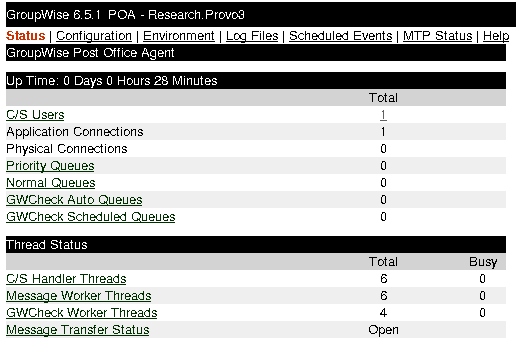
For instructions on protecting the agent Web consoles with passwords see "Using the POA Web Console" in "Post Office Agent" and "Using the MTA Web Console" in "Message Transfer Agent" in the GroupWise 6.5 Administration Guide.
Using Agent Startup Files
The agent startup files are created by the Installation Advisor in the /opt/novell/groupwise/agents/share directory and are named after the domain or post office that the agent services. Because the Installation Advisor prompted you for domain and post office names and directories, it can set the --home startup switches in the MTA and POA startup files. In the bin directory where the agent executables are located, you could start the agents with commands similar to the following examples:
./gwmta --show @../share/LnxDom.mta
./gwpoa --show @../share/LnxPost.poa
Starting the Linux Agents on System Startup
If you selected Launch GroupWise Agents on System Startup in the Agent Installation program, the Agent Installation program configured your system so that the agents would start automatically each time you restart your server. The Agent Installation program always creates a grpwise startup script in /etc/init.d for starting the agents. To enable automatic startup, the Agent Installation program also creates symbolic links named S99grpwise in the rc3.d and rc5.d directories so that the agents load on restart into level 3 or 5, depending on the configuration of your Linux system.
When the grpwise script runs and starts the agents, it reads the agent startup files in /opt/novell/groupwise/agents/share to check for configuration information provided by startup switches. Because the --show switch cannot be used in the startup files, the agents never run with agent console interfaces when started automatically when the server restarts.
Stopping the Linux Agents
When you use the --show startup switch to start the MTA and POA, you can stop them from the agent console interface.
When you start the GroupWise agents with the grpwise script, you can also use the script to stop them.
-
Make sure you are logged in as root.
-
Change to the /etc/init.d directory.
-
To stop the GroupWise agents, enter the following command:
./grpwise stop
-
To confirm that the agents have stopped, enter the following commands:
ps -eaf | grep gwmta
ps -eaf | grep gwpoaThe only gwmta and gwpoa process IDs you should see listed are the ones for the grep commands.
When you start the GroupWise agents manually (without using the grpwise script), use the standard Linux kill command to stop them.
-
Make sure you are logged in as root.
-
Determine the process IDs (PIDs) of the MTA and POA:
ps -eaf | grep gwmta
ps -eaf | grep gwpoaThe PIDs for all gwmta and gwpoa processes are listed.
-
Kill the first process listed for each agent:
It might take a few seconds for all agent processes to terminate.
-
Repeat the ps commands to verify that the agents have stopped.
Setting Up the GroupWise Agents on Windows
Complete the following tasks to set up the Windows agents. These tasks are designed to help you get the Windows agents up and running as quickly as possible:
Preparing the Windows Server for the Windows Agents
Make sure the Windows server where you plan to install the GroupWise Windows agents has been properly prepared to run the agents:
- Obtaining a Static IP Address
- Mapping Drives to Post Offices and Domains
- Creating a Windows User Account for Remote Access (Optional)
- Enabling SNMP (Optional)
Obtaining a Static IP Address
The Windows server where the GroupWise Windows agents run should have a static IP address. DHCP should not be used to dynamically assign an IP address for it. Make sure the server where you plan to install the Windows agents has a static IP address.
Mapping Drives to Post Offices and Domains
The POA requires direct access to the post office directory and the MTA requires direct access to the domain directory. If the agents are not installed on the same server where their directories are located, make sure the server has drives mapped to all locations where the agents need access.
After installation, the agents can access their directories using either mapped drives or UNC paths. However, mapped drives are required during installation so that the agent startup files can be set up properly.
Creating a Windows User Account for Remote Access (Optional)
If you specified a new Windows username and password under Worksheet Item 9: Windows Services Information, create the new Windows user account so it is ready when you start the agents for the first time. Follow the instructions for your Windows version:
- In Windows NT, click Start > Programs > Administrative Tools > User Manager to create a new user.
- In the Control Panel of Windows 2000, double-click Users and Passwords to add a new user.
Grant the user Full Control rights in the domain and post office directories.
Enabling SNMP (Optional)
If you want to monitor the GroupWise Windows agents from an SNMP manager program, such as the Management and Monitoring Services component of Novell ZENworks Server Management, SNMP must be enabled on the Windows server where the agents are installed. If it is not already enabled, you should enable it before you run the Agent Installation program. Follow the instructions for your Windows version:
- In the Control Panel in Windows NT, double-click Network > click Services > Add > double-click SNMP.
- In the Control Panel in Windows 2000, double-click Add/Remove Programs > click Add/Remove Windows Components > double-click Management and Monitoring Tools > select Simple Network Management Protocol.
Installing the Windows Agent Software
After you have prepared the Windows server to run the GroupWise Windows agents, you are ready to install them.
At the Windows server where you want to install the Windows agents:
-
Make sure you have mapped drives to all domain and post office directories for which you are installing agents.
-
Run setup.exe at the root of the GroupWise 6.5 Administrator CD > click Install Products > GroupWise Agents > Install GroupWise Agents.
or
Run install.exe from the \agents subdirectory on the CD or in your software distribution directory if you have updated it with GroupWise 6.5 software.
-
Follow the on-screen instructions to install the GroupWise agents on the Windows server, supplying the information you gathered on the GroupWise Agent Installation Worksheet, until you reach the Installation Complete page.
-
Choose whether or not you want the Agent Installation program to start the agents for you immediately, then click Finish.
If you encounter any problems starting the agents or if you chose not to have the Agent Installation program start the agents for you, see "Post Office Agent" and "Message Transfer Agent" in the GroupWise 6.5 Administration Guide for additional instructions.
If you need to stop the agents and they are running as applications in their own windows, click File > Exit in each window. If they are running as Windows services, open the Services window (from the Control Panel or Administrative Tools), right-click each agent service, then click Stop.
-
To monitor an agent from your Web browser, view the agent Web console by supplying the IP address and port number of the agent. For example:
http://172.16.5.18:1677
http://172.16.5.18:7100
http://172.16.5.18:7180
http://172.16.5.18:7181When viewing the agent Web console, you can specify the POA client/server port, the MTA message transfer port, or the HTTP port you specified when you created the post office or domain.